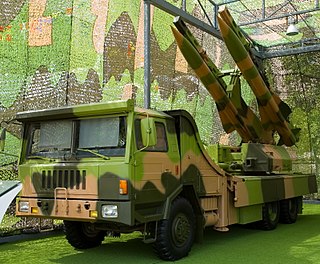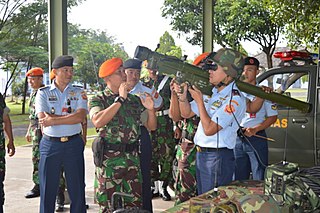 W
WFN-6 or Feinu-6 is a third generation passive infrared homing (IR) man portable air defence system (MANPADS). It was developed by China, and is their most advanced surface-to-air missile offered in the international market. Specially designed to engage low flying targets, it has a range of 6 km and a maximum altitude of 3.8 km. The FN-6 is in service with the People's Liberation Army (PLA), and has also been exported to Malaysia, Cambodia, Sudan, Pakistan and Peru. Based on FN-6, China has developed a number of other MANPADS, such as HN and FY series, as well as other vehicle-based short-range air defense systems such as FN and FB series.
 W
WThe S-75 is a Soviet-designed, high-altitude air defence system, built around a surface-to-air missile with command guidance. Following its first deployment in 1957 it became one of the most widely deployed air defence systems in history. It scored the first destruction of an enemy aircraft by a surface-to-air missile, with the shooting down of a Taiwanese Martin RB-57D Canberra over China on 7 October 1959 that was hit by a salvo of three V-750 (1D) missiles at an altitude of 20 km (65,600 ft). This success was credited to Chinese fighter aircraft at the time to keep the S-75 program secret.
 W
WThe S-75 is a Soviet-designed, high-altitude air defence system, built around a surface-to-air missile with command guidance. Following its first deployment in 1957 it became one of the most widely deployed air defence systems in history. It scored the first destruction of an enemy aircraft by a surface-to-air missile, with the shooting down of a Taiwanese Martin RB-57D Canberra over China on 7 October 1959 that was hit by a salvo of three V-750 (1D) missiles at an altitude of 20 km (65,600 ft). This success was credited to Chinese fighter aircraft at the time to keep the S-75 program secret.
 W
WHQ-2J or Hongqi-2 (红旗二号导弹) are anti-aircraft missiles mounted on the Type 77 transporter launcher. It is an upgraded version of the HQ-2 system. The HQ-1/HQ-2 are developed from the Soviet S-75 Dvina SA-2 system. The HQ-2 has been China's primary air defence system for over forty years but since 2016 it is being replaced by the HQ-22 system.
 W
WThe HQ-7 (FM-80) is a Chinese short-range low altitude air defense missile reverse engineered from the French Crotale. The missile is deployed on both ships and land-based vehicles. China revealed the export version, FM-80, in the 1989 Dubai Air Show. Unit cost is around $162,000 per launcher and $24,500 per missile.
 W
WThe HQ-9 is a medium- to long-range, active radar homing surface-to-air missile.
 W
WThe HQ-10 is a short range surface-to-air missile designed by China Aerospace Science and Technology Corporation (CASC), currently in service as a point defense missile system aboard PLA Navy warships.
 W
WThe HQ-16 is a medium range semi-active radar homing surface-to-air missile developed by the People's Republic of China.
 W
WThe HQ-17 is an all-weather low to medium altitude, short-range surface-to-air missile system developed by China for the People's Liberation Army.
 W
WThe Kai Shan - 1 (KS-1) (凯山一号) is the first Chinese surface-to-air missile to adopt a phased array radar.
 W
WThe PL-12 is an active radar-guided beyond-visual-range air-to-air missile developed by the People's Republic of China. It is considered comparable to the US AIM-120 AMRAAM and the Russian R-77.
 W
WThe People's Republic of China-developed QW-1 Vanguard is an all-aspect man-portable surface-to-air missile, from which a series of missiles were developed.
 W
WThe QW-2 Vanguard 2 is a Chinese all-aspect man-portable infrared homing guided surface-to-air missile. It is not clear when the missile first entered service, but it is likely to have been between 1998 and 2002.